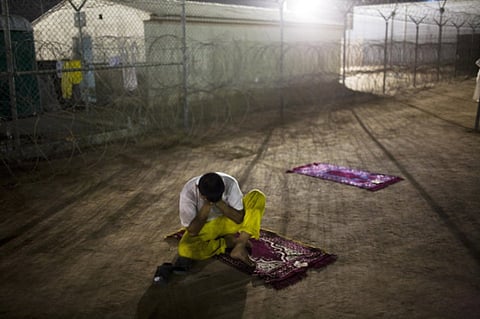How Camp Bucca gave birth to Daesh
Mix of Baathist and Islamist prisoners in US detention centres paved the way

Washington: In March 2009, in a wind-swept sliver of Iraq, a sense of uncertainty befell the southern town of Garma, home to one of the Iraq war’s most notorious prisons. The sprawling detention centre called Camp Bucca, which had detained some of the Iraq war’s most radical militants along the Kuwait border, had just freed hundreds of inhabitants. Families rejoiced, anxiously awaiting their sons, brothers and fathers who had been lost to Bucca for years, but a local official fretted.
“These men weren’t planting flowers in a garden,” police chief Sa’ad Abbas Mahmoud told the Washington Post’s Anthony Shadid, estimating 90 per cent of the freed prisoners would soon resume fighting. “They weren’t strolling down the street. This problem is both big and dangerous. And regrettably, the Iraqi government and the authorities don’t know how big the problem has become.”
Mahmoud’s assessment of Camp Bucca, which funnelled 100,000 detainees through its barracks and closed months later, would prove prescient. The camp now represents an opening chapter in the history of Daesh - many of its leaders, including Abu Bakr Al Baghdadi, were incarcerated and likely met there. According to former prison commanders, analysts and soldiers, Camp Bucca provided a unique setting for both prisoner radicalization and inmate collaboration - and was formative in the development today’s most potent jihadist force.
In all, nine members of the Daesh’s top command did time at Bucca, according to the terrorist analyst organisation Soufan Group.
Apart from Al Baghdadi himself, who spent five years there, the leader’s No 2, Abu Muslim Al Turkmani, as well as senior military leader Haji Bakr, now deceased, and leader of foreign fighters Abu Qasim were incarcerated there, Soufan said. Though it’s likely the men were extremists when they entered Bucca, the group added, it’s certain they were when they left.
“Before their detention, Al Baghdadi and others were violent radicals, intent on attacking America,” wrote military veteran Andrew Thompson and academic Jeremi Suri in the New York Times this month. “Their time in prison deepened their extremism and gave them opportunities to broaden their following... The prisons became virtual terrorist universities: The hardened radicals were the professors, the other detainees were the students, and the prison authorities played the role of absent custodian.”
It’s a scenario that’s long confounded law enforcement: How do you crack down on extremism without creating more of it? From the radicalization of white supremacists in US prisons to the United Kingdom’s disastrous bid in the 1970s to incarcerate Irish Republican Army members, the problem is nothing new: Prisons are pools of explosive extremism awaiting a spark.
And at Camp Bucca, there was no shortage of sparks. As news of Al Baghdadi’s tenure at Bucca emerged, former prison commander James Skylar Gerrond remembered many of them. “Re: Badghadi,” he wrote on Twitter in July, “many of us at Camp Bucca were concerned that instead of just holding detainees, we had created a pressure cooker for extremism”. He worked at the prison between 2006 and 2007, when it was glutted with tens of thousands of radicals, including Al Baghdadi.
Many were guilty of attacking American soldiers. But many more were not — “simply being a ‘suspicious looking’ military-aged male in the vicinity of an attack was enough to land one behind bars,” according to the Times opinion piece. Shadid reported as much in 2009, confirming many viewed it “as an appalling miscarriage of justice where prisoners were not charged or permitted to see evidence against them [and] freed detainees may end up swelling the ranks of a subdued insurgency”.
That this subdued insurgency eventually caught fire isn’t much of a surprise. At the height of the Iraq surge in 2007, when the prison was glutted with 24,000 inmates, it seethed with extremism. Inhabitants were divided along sectarian lines to ameliorate tension, a military report said, and inmates settled their disputes with Islamic law. “Inside the wire at these compounds are Islamist extremists who will maim or kill fellow detainees for behavior they consider against Islam,” the military report said.
“Sharia courts enforce a lot of rules inside the compounds,’” one soldier quoted in the report said. “’Anyone who takes part in behavior which is seen as ‘western’ is severely punished by the extremist elements of the compound... It’s quite appalling sometimes.’ “
Prison commanders such as Gerrond observed the growing extremism. “There was a huge amount of collective pressure exerted on detainees to become more radical in their beliefs,” he told Mother Jones. “... detainees turn[ed] to each other for support. If there were radical elements within this support network, there was always the potential that detainees would become more radical.”
But the unique setting at Bucca, which thrust together Saddam Hussain’s Baathist secularists and Islamist fundamentalists, set the stage for something perhaps worse: collaboration. At the prison, the two seemingly incongruous groups joined to form a union “more than a marriage of convenience,” Soufan reported.
Soufan found each group offered the other something it lacked. In the ex-Baathists, militants found organisational skills and military discipline. In the militants, ex-Baathists found purpose. “In Bucca, the math changed as ideologies adopted military and bureaucratic traits and as bureaucrats became violent extremists,” the Soufan report said.
From the ashes of what former inmates called an “Al Qaida school,” rose the Daesh. Indeed, when those inhabitants freed in 2009 returned to Baghdad, the Post reported, they spoke of two things: Their conversion to radicalism — and revenge.
— Washington Post
Sign up for the Daily Briefing
Get the latest news and updates straight to your inbox



